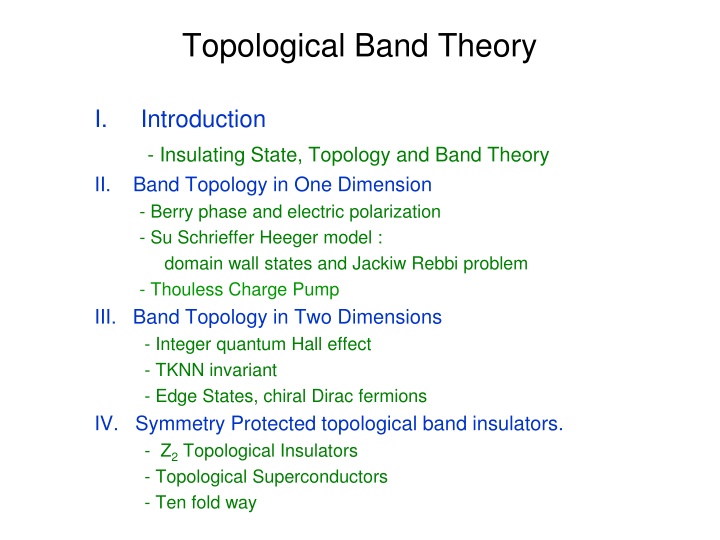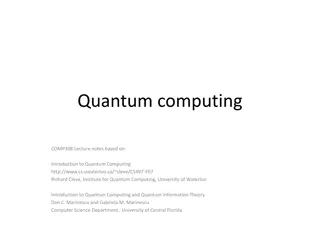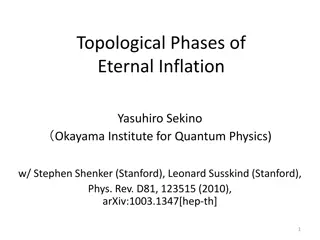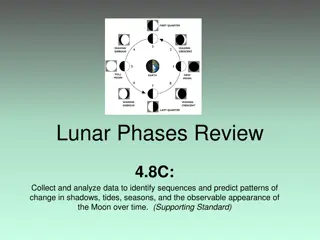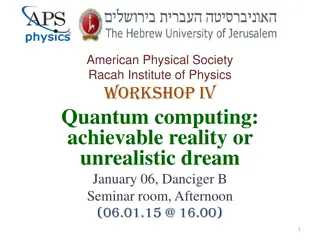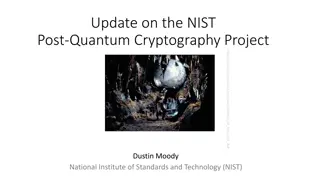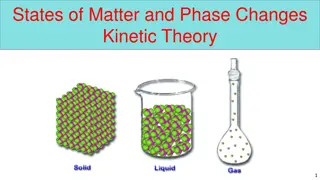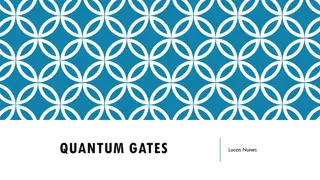Exploring Topological Band Theory and Quantum Phases in Electronic Matter
Delve into the fascinating realm of topological band theory, examining the insulating state, band topology in different dimensions, symmetry-protected topological band insulators, and the interplay between symmetry and topology. Uncover the principles underlying matter symmetry, quantum phases, and topological equivalence. Discover various topological electronic phases and their significance, including topological superconductivity and beyond band theory explorations of strongly correlated states with intrinsic topological order.
Download Presentation

Please find below an Image/Link to download the presentation.
The content on the website is provided AS IS for your information and personal use only. It may not be sold, licensed, or shared on other websites without obtaining consent from the author.If you encounter any issues during the download, it is possible that the publisher has removed the file from their server.
You are allowed to download the files provided on this website for personal or commercial use, subject to the condition that they are used lawfully. All files are the property of their respective owners.
The content on the website is provided AS IS for your information and personal use only. It may not be sold, licensed, or shared on other websites without obtaining consent from the author.
E N D
Presentation Transcript
Topological Band Theory I. Introduction - Insulating State, Topology and Band Theory II. Band Topology in One Dimension - Berry phase and electric polarization - Su Schrieffer Heeger model : domain wall states and Jackiw Rebbi problem - Thouless Charge Pump III. Band Topology in Two Dimensions - Integer quantum Hall effect - TKNN invariant - Edge States, chiral Dirac fermions IV. Symmetry Protected topological band insulators. - Z2Topological Insulators - Topological Superconductors - Ten fold way
Organizing Principles for Understanding Matter Symmetry Conceptual simplification Conservation laws by pattern of broken symmetries Distinguish phases of matter symmetry group p31m symmetry group p4 Topology smooth deformation Properties insensitive to Quantized topological numbers of matter Distinguish topological phases genus = 1 genus = 0 Interplay between symmetry and topology has led to a new understanding of electronic phases of matter.
Topology and Quantum Phases Topological Equivalence : Principle of Adiabatic Continuity Many body energy spectrum E Quantum phases with an energy gap are topologically equivalent if they can be smoothly deformed into one another without closing the gap. excited states Topologically distinct phases are separated by quantum phase transition. Gap EG topological quantum critical point Ground state E0 adiabatic deformation Single particle energy spectrum Topological Band Theory E Describe states that are adiabatically connected to non interacting fermions Eg ~ 1 eV Classify single particle Bloch band structures Bloch Hamiltonans with ener Brillouin zone (tor us ) ( ) : H k gy gap k Band Theory of Solids e.g. Silicon
Topological Electronic Phases Many examples of topological band phenomena States adiabatically connected to independent electrons: - Quantum Hall (Chern) insulators - Topological insulators - Weak topological insulators - Topological crystalline insulators - Topological (Fermi, Weyl and Dirac) semimetals .. Many real materials and experiments Topological Superconductivity Tantalizing recent experimental progress Proximity induced topological superconductivity Majorana bound states, quantum information Beyond Band Theory: Strongly correlated states State with intrinsic topological order - fractional quantum numbers - topological ground state degeneracy - quantum information Much recent conceptual progress, but theory is still far from the real electrons - Symmetry protected topological states - Surface topological order
Band Theory of Solids Bloch Theorem : = k R = i k r ( ) R ie ( ) k T e u Lattice translation symmetry = = k r k r i i ( ) k ( ) k ( ) k ( ) k ( ) k H u E u H e e Bloch Hamiltonian n n n ky /a = Brillouin Zone Torus, k = kx d T /a /a BZ /a Band Structure : Egap k ( ) k A mapping H E (or equivalently to and ) ( ) k ( ) k E u n n /a /a kx
Berry Phase Phase ambiguity of quantum mechanical wave function ( ) u e k i ( ) k ( ) k u = k A ( ) k ( ) k i u u Berry connection : like a vector potential + k A A ( ) k A = k d Berry phase : change in phase on a closed loop C C C = F = 2 F A d k Berry curvature : k C S Famous example : eigenstates of 2 level Hamiltonian S d + d id C z x y = = ( ) k ( ) d k H d d id d x y z ( ) 1 2 =+ ( ) ( ) u k k ( ) d k ( ) k H u d k = Solid Angle swept out by ( ) C
Topology in one dimension : Berry phase and electric polarization 1D insulator Classical electric polarization : -Qend +Qend dipole moment length = P n bound = Q P P = end Quantum polarization : a Berry phase Bloch states are defined for periodic boundary conditions ( ) ( ) k k r e u r = ikr Define localized Wannier States : ( ) Rr dk dk = = ( ) ikR ik R r ( ) R e e u k k 2 2 BZ BZ R r ie Wannier states associated with R are localized, but gauge dependent. = ( ) R r = ( ) R P e R u u k k k 2 BZ k e = k A ( ) k ( ) k i u u /a = ( ) A k dk P 0 - /a 2 BZ BZ = 1D Brillouin Zone = S1
Gauge invariance and intrinsic ambiguity of P The end charge is not completely determined by the bulk polarization P because integer charges can be added or removed from the ends : = mod Q P e end The Berry phase is gauge invariant under continuous gauge transformations, but is not gauge invariant under large gauge transformations. P en + P ( / ) = ( ) k ( / ) a 2 i a n ( ) u k ( ) u k e when with Changes in P, due to adiabatic variation are well defined and gauge invariant C 1 ( , ( )) u k ( ) u k t e e = = = A dkd F P P P dk S = = 1 0 2 2 C S k 0 gauge invariant Berry curvature - /a /a
model for polyacetylene simplest two band model Su Schrieffer Heeger Model = + t c c + + Ai Bi Ai E(k) ( ) ( ) . . H t t t c c hc + 1 Bi Gap 4| t| i k B,i t 0 A,i A,i+1 a /a /a t 0 Peierls instability t dy d(k) = ( ) k d ( ) H k t>0 : Berry phase 0 P = 0 dx = = = + + ( ) ( ) ( ( ) ( )sin )cos d k d k t t t t t t ka x dy ka y d(k) t<0 : Berry phase P = e/2 ( ) 0 d k z dx Provided symmetry requires dz(k)=0, the states with t>0 and t<0 are distinguished by an integer winding number. Without extra symmetry, all 1D band structures are topologically equivalent.
Symmetries of the SSH model = = (or ) ( ), 0 ( ) ( ) H k H k H k Chiral Symmetry : z z z c c c Artificial symmetry of polyacetylene. Consequence of bipartite lattice with only A-B hopping: iA iA c iB iB Requires dz(k)=0 : integer winding number Leads to particle-hole symmetric spectrum: = = H E z E z E z E E Reflection Symmetry : Real symmetry of polyacetylene. = ( ) ( ) H k H k x x Allows dz(k) 0, but constrains dx(-k)= dx(k), dy,z(-k)= -dy,z(k) No p-h symmetry, but polarization is quantized: Z2 invariant P = 0 or e/2 mod e
Topological Boundary Modes Boundary between topologically distinct insulators Topological boundary modes B A Su Schrieffer Heeger Model (1979) Polyacetalene (CH)n Jackiw Rebbi Model (1976) 0(x) m(x) = v + ( ) H i m x x x y } 0 = = { , H chiral symmetry: z z E E Single Particle Spectrum: E x 1 0 ( ') '/v m x dx F = ( ) x e 0 0 Topological zero energy bound state 0 Many body ground state: Charge fractionalization: A A B e/2 e/2 Splitting the indivisible
Thouless Charge Pump The integer charge pumped across a 1D insulator in one period of an adiabatic cycle is a topological invariant that characterizes the cycle. t=0 P=0 + = ( , ) ( , ) H k t H k t T P=e t=T t=T ( ) e = = ( , ) A k T dk ( ,0) A k P dk ne = 2 k t=0 - /a /a 1 F = n dkdt 2 2 T The integral of the Berry curvature defines the first Chern number, n, an integer topological invariant characterizing the occupied Bloch states, ( , ) u k t ( , ), k t d In the 2 band model, the Chern number is related to the solid angle swept out by which must wrap around the sphere an integer n times. ( , ) k t d 1 d d d = ( ) n dkdt k t 4 2 T
TKNN Invariant Thouless, Kohmoto, Nightingale and den Nijs 82 = k ( ) ( ) k ( ) k i u u k For 2D band structure, define ky /a 1 1 C1 = A k A k n d d BZ 2 2 C C kx /a 1 2 /a 1 = = 2 ( ) F k d k C2 2 BZ /a 2 e = nh Physical meaning: Quantized Hall conductivity xy Laughlin argument: Thread flux = h/e = / Ea d dt (Faraday s law) = = / I Ea d dt I xy xy E = = = / P Idt h e -ne ne xy xy Thouless pump: Cylinder with circumference 1 lattice constant (a) = P ne = = 2 / plays role of ky / h e k a y Alternative calculation: compute xy via Kubo formula
Realizing a non trivial Chern number E Integer quantum Hall effect: = E g c Landau levels Chern insulator: k e.g. Haldane model Eg Chern Band C=1 conduction band Band Inversion Paradigm E E valence band k k
E Lattice model for Chern insulator conduction band z = +1 s ( ) k = + + ( ) k 2 cos cos H t k a k a E ? ? ? 0 z x y sp valence band z = -1 ( ) ? p+ip + + = ( ) k d 2 sin sin t k a k a sp x x y y Square lattice model with inversion of bands with s and px+ipy symmetry near dx d(k) | Esp| > 4t : Uninverted Trivial Insulator dz Chern number 0 dy dx d(k) dz | Esp| < 4t : Inverted Chern Insulator Chern number 1 dy Regularized continuum model for Chern insulator m = 4t0- Esp a = t0 a v = 2tsp a ( ) ( ) = + + x x + = 2 v ( ) k ( ) k d H m ak k k z y y Inverted near k=0 for m<0. Uninverted for ?
Edge States Gapless states at the interface between topologically distinct phases IQHE state n=1 n=0 Vacuum n=0 n=1 y m= +m0 m= m0 x m>0 Edge states ~ skipping orbits Lead to quantized transport Domain wall bound state 0 m<0 Egap Band inversion transition : Dirac Equation E0 = + + ky v ( ) ( ) H i k m x F x x y y z x ( ') '/v m x dx F = ( ) v E k k ik y 0( ) ~ x e e y 0 0 F y y Chiral Dirac Fermions
Chiral Dirac Fermion conduction band E Insulator EF Quantum Hall State valence band 0 /a /a kx Single particle picture: Bulk Boundary correspondence # chiral edge modes = (Chern Number) One way propagation perfect transmission, responsible for quantized conductance insensitive to disorder, impossible to localize Doubling Theorem Chiral Dirac fermions can not exist in purely 1D system
Many-body edge spectrum : chiral Fermi liquid = i x Free Dirac fermion conformal field theory v H Neutral excitations: particle-hole pairs ~ chiral phonons E E vq k = + q v ( q b b 1/ 2) H neutral q q q q v = 2 ( ) H N N Charged excitations: electron charge e arg 0 ch e 2 L Quantizd Response: 2e h = 1 = G Quantized electrical conductance 2 2 B k h c = 1 chiral central charge = c T Quantized thermal conductance: 3 Chiral Anomaly : In the presence of electric field, edge charge is not conserved dQ dt e dk e eE += = = E xy 2 2 dt
1D electrical conductor Low energy excitations: Right/Left moving chiral fermions potential or disorder. Localized by commensurate periodic R L Split the 1D chiral modes in a 2D insulator: wire construction Trivial Insulator separated chiral boundary modes Topological Chern insulator aka quantum Hall state Trivial Insulator
Symmetry Protected Topological Band Insulators The presence of symmetry can rule out some topological states, but can also introduce new ones Time Reversal Symmetry Chern number n=0 Z2 topological insulator in d=2,3 Superconductivity: particle-hole symmetry of BdG Hamiltonian Z2 topological superconductor d=1 Z topological superconductor d=2 Crystal symmetry translation : weak topological insulator reflection : topological crystalline insulator rotation non symmorphic glides, screws
Time Reversal Symmetry y e [ , ] H = = / i S Anti Unitary time reversal operator : 0 * = 2 * 1 Spin : = * Kramers Theorem: for spin all eigenstates are at least 2 fold degenerate = c = 2 2 Proof : for a non degenerate eigenstate | | c 1 | | c = 2 2 Quantum spin Hall insulator : Split 1D conductor preserving T symmetry R , L , 1D 2D QSHI split Helical Edge States : E conduction band protected by time reversal EF Requires spin orbit interaction valence band /a Simplest model: two copies of chern insulator /a 0
Z2 Topological Insulator There are two classes of time reversal invariant insulators Distinguished by Z2 topological invariant = 0, 1 Two patterns of edge states: =1 : Topological Insulator =0 : Conventional Insulator Kramers degenerate at time reversal invariant momenta k* = k* + G k*= /a k*=0 k*= /a k*=0 Odd number of bands crossing Fermi energy Even number of bands crossing Fermi energy
Physical Meaning of 2 Invariant Sensitivity to boundary conditions in a multiply connected geometry =N IQHE on cylinder: Laughlin Argument = 0 = h/e Q = N e Flux 0 Quantized change in Electron Number at the end. Quantum Spin Hall Effect on cylinder = 0 / 2 Kramers Degeneracy Flux 0 /2 Change in Electron Number Parity at the end, signaling change in Kramers degeneracy. No Kramers Degeneracy
Formula for the 2 invariant Bloch wavefunctions : n u k ( ) (N occupied bands) = k U ( ) N ( ) k ( ) k ( ) w u u T - Reversal Matrix : mn m n Antisymmetry property : = = 2 T k k 1 ( ) w ( ) w T - invariant momenta : = = = T k ( w ) ( ) w a a a a = 0 - z ky Pfaffian : ( ) 2 = det[ ( )] Pf[ ( )] w w 2 e.g. det z a a 0 z 3 4 kx Pf[ ( det[ ( )] w Fixed point parity : = = ( ) 1 a a 1 2 )] w ) ( a Gauge dependent product : ( ) a e b ( ) A k dk time reversal polarization analogous to Bulk 2D Brillouin Zone 2 4 Z2 invariant : ( 1) = = ( ) 1 a = 1 a Gauge invariant, but requires continuous gauge
is easier to determine if there is extra symmetry: 1. (due to time reversal) n = Sz conserved : independent spin Chern integers : n J J = , mod 2 n Quantum spin Hall Effect : E 2. 2D Bloch states Inversion (P) Symmetry : determined by Parity of occupied P = ( ) ( ) ( ) n a n a n a 4 ( 1) = = ( ) ( ) 1 n a 2 n a = 1 a n In a special gauge: = ( ) ( ) a n a n Allows a straightforward determination of from band structure calculations.
Quantum Spin Hall Effect in HgTe quantum wells Theory: Bernevig, Hughes and Zhang, Science 06 d < 6.3 nm : Normal band order E d > 6.3 nm : Inverted band order E HgTe HgxCd1-xTe 6 ~ s 8 ~ p 8 ~ p k k d HgxCd1-xTe 6 ~ s Egap~10 meV Band inversion transition: Switch parity at k=0 Quantum spin Hall Insulator with topological edge states Conventional Insulator = + 2( n ) 1 = 2( n ) 1 a a BHZ Model : 4 band T-invariant band inversion model ( ) ( ) = + + x x + 2 v ( ) k H m ak k k z x y x y
3D Topological Insulators There are 4 surface Dirac Points due to Kramers degeneracy ky E E 3 4 kx OR 1 2 2D Dirac Point k= a How do the Dirac points connect? Determined by 4 bulk Z2 topological invariants 0 ; ( 1 2 3) ky k= b k= a k= b Surface Brillouin Zone 0 = 0 : Weak Topological Insulator kx Related to layered 2D QSHI ; ( 1 2 3) ~ Miller indices Fermi surface encloses even number of Dirac points 0 = 1 : Strong Topological Insulator ky EF Fermi circle encloses odd number of Dirac points Topological Metal : 1/4 graphene Berry s phase Robust to disorder: impossible to localize kx
Topological Invariants in 3D 1. 2D 3D : Time reversal invariant planes kz The 2D invariant a /a 4 Pf[ ( det[ ( )] w ( 1) = = ( ) ( ) a a a )] w = 1 a a ky Each of the time reversal invariant planes in the 3D Brillouin zone is characterized by a 2D invariant. /a /a kx Weak Topological Invariants (vector): G 4 2 ( ) ( 1) = ( ) = G , , i ki=0 plane a 1 2 3 a = 1 a mod 2 reciprocal lattice vector indexes lattice planes for layered 2D QSHI Strong Topological Invariant (scalar) 8 ( 1) = ( ) o a = 1 a
Topological Invariants in 3D 2. 4D 3D : Dimensional Reduction Add an extra parameter, k4, that smoothly connects the topological insulator to a trivial insulator (while breaking time reversal symmetry) H(k,k4) is characterized by its second Chern number = ( ,1) k H H (Trivial insulator) 0 1 = ( ,0) k ( ) k = k4 H H 4 Tr F F [ ] n d k 2 8 = 1 ( , k ( , k ) ) H k H k 4 4 n depends on how H(k) is connected to H0, but due to time reversal, the difference must be even. = mod 2 n 0 = Tr F F [ ] dQ Express in terms of Chern Simons 3-form : 1 ( ) 4 3 2 3 = = + 3 d mod Tr k ( ) k A A A A A 2 [ ] kQ Q d 0 3 3 2 Gauge invariant up to an even integer.
